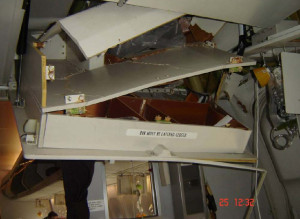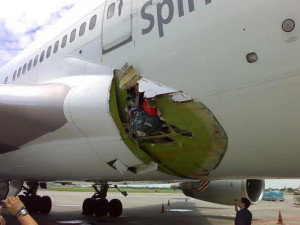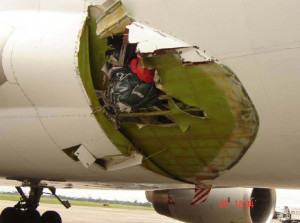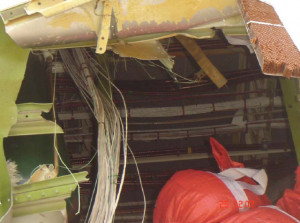An emergency oxygen bottle (O2 cylinder) exploded in the luggage compartment of a Boeing 747 plane carrying 365 passengers. The aircraft, whose cabin needed to be depressurised following a sudden 6,000-m drop, landed using an emergency manoeuvre at the Manila Airport in the Philippines. No victims were reported.
Due to periodic movements and replacements (maintenance / filling), the bottle (constructed in February 1996) had been inside the plane since 14th June, 2008. This type of aircraft was designed with 12 other comparable cylinders (outer diam. = 22.8 cm, length = 75.1 cm, thickness = 2.87 mm, pressure = 128 bar). According to investigators, who did not specify whether the bottle had disintegrated or exploded, the bottom of the reservoir that had become detached from the shell combined with the pressure released caused a 3-m hole to form in the plane’s fuselage, while flying at an altitude of 8,800 m, with the remainder of the bottle then perforating during its trajectory a floor (20-cm hole in the cabin floor above the bottle’s designated spot) before losing its valve when slamming against the plane’s inner wall and falling again on this same floor. Several small metal fragments and a portion of the bottle valve were actually found inside the aircraft. No traces of combustion were recorded near the cylinder’s initial location or at its connections, or for that matter on the fuselage.
This event would have been the first of its type ever recorded on a commercial line aircraft. Among the initial measures adopted, the airline company implemented straight away a visual verification programme dedicated to this type of pressurised reservoir throughout its Boeing 747 fleet. Additional investigations were conducted, notably on the incriminated reservoir or at least on similar bottles (96 cylinders built in February 1996 based on the same specifications): quality and manufacturing inspections. Since a number of incidents had occurred on this company’s fleet over the previous few weeks, Australian authorities grew concerned and also ordered specific controls.







